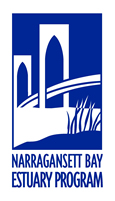Narragansett Bay: An Estuary of National Significance Results
of the Narragansett Bay Coastal Wetland Trend Analysis Maps
of Trends in Narragansett Bay Coastal Wetlands
|
|
Narragansett Bay: An Estuary of National Significance Narragansett Bay is an estuary that is located predominantly in eastern Rhode Island and southeastern Massachusetts. The Bay’s watershed covers an area 1,600 square miles, of which 60 percent exists in Massachusetts, and 40 percent is in Rhode Island. An estuary is a partially enclosed body of water where fresh water from the rivers and streams mixes with the salt water from the ocean to form some of the most important and diverse habitats in the world. A habitat is a place where plants and animals live and grow. The Bay’s coastal wetland habitat provides food, shelter and nursery or nesting areas for a variety of important fish, shellfish, birds, turtles, and mammals. They also help maintain water quality and health of estuaries by filtering pollutants and recycling nutrients. In addition, coastal wetlands protect lands along the coast from storm and wave damage. Coastal wetlands are vulnerable to human disturbances that occur on the land and in the water. Pollution in the form of excess nutrients, sediments, bacteria, chemicals and other contaminants reduce the habitat and water quality. Activities related to coastal development, such as ditching, filling, restricting tidal flow, diking and impoundments, and shoreline hardening, can cause permanent losses of habitat.
In 1987, as part of the Clean Water Act, Congress established the National Estuary Program to recognize and protect estuaries of national significance. Narragansett Bay is one of 28 national estuaries in this program. The Narragansett Bay Estuary Program receives funding from the U.S. Environmental Protection Agency to implement a conservation and management plan for the Bay. The Plan identifies goals to protect, manage, and restore coastal habitat resources. The Program achieves these goals by engaging State and Federal agencies, universities, nongovernmental organizations, and local communities in planning and management decisions, forming partnerships, and performing cooperative projects. For more information about the Narragansett Bay Estuary Program, visit the web site at www.nbep.org.
|
